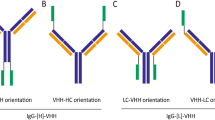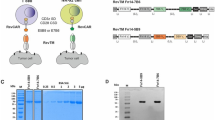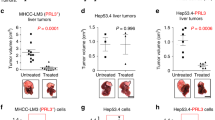Abstract
Selective cytotoxicity to cancer cells without compromising their normal counterparts pose a huge challenge for traditional drug design. Here we developed a tumor antigen-targeted delivery of immunonanoparticle carrying a novel non-immunosuppressive FTY720 derivative OSU-2S with potent cytotoxicity against leukemic B cells. OSU-2S induces activation of protein phosphatase 2A (PP2A), phosphorylation and nuclear translocation of SHP1S591 and deregulation of multiple cellular processes in chronic lymphocytic leukemia (CLL) resulting in potent cytotoxicity. To preclude OSU-2S-mediated effects on these ubiquitous phosphatases in unintended cells and avoid potential adverse effects, we developed an OSU-2S-targeted delivery of immunonanoparticles (2A2-OSU-2S-ILP), that mediated selective cytotoxicity of CLL but not normal B cells through targeting receptor tyrosine kinase ROR1 expressed in leukemic but not normal B cells. Developing a novel spontaneous CLL mouse model expressing human ROR1 (hROR1) in all leukemic B cells, we demonstrate the therapeutic benefit of enhanced survival with 2A2-OSU-2S-ILP in vivo. The newly developed non-immunosuppressive OSU-2S, its delivery using human CLL directed immunonanoparticles and the novel transgenic (Tg) mouse model of CLL that expresses hROR1 exclusively in leukemic B cell surface are highly innovative and can be applied to CLL and other ROR1+ malignancies including mantle cell lymphoma and acute lymphoblastic leukemia.
This is a preview of subscription content, access via your institution
Access options
Subscribe to this journal
Receive 12 print issues and online access
$259.00 per year
only $21.58 per issue
Buy this article
- Purchase on Springer Link
- Instant access to full article PDF
Prices may be subject to local taxes which are calculated during checkout






Similar content being viewed by others
References
Rai KR, Sawitsky A, Cronkite EP, Chanana AD, Levy RN, Pasternack BS . Clinical staging of chronic lymphocytic leukemia. Blood 1975; 46: 219–234.
Binet JL, Lepoprier M, Dighiero G, Charron D, D'Athis P, Vaugier G et al. A clinical staging system for chronic lymphocytic leukemia: prognostic significance. Cancer 1977; 40: 855–864.
Danilov AV . Targeted therapy in chronic lymphocytic leukemia: past, present, and future. Clin Ther 2013; 35: 1258–1270.
Davids MS, Brown JR . Targeting the B Cell receptor pathway in chronic lymphocytic leukemia. Leuk Lymphoma 2012.
Neviani P, Santhanam R, Trotta R, Notari M, Blaser BW, Liu S et al. The tumor suppressor PP2A is functionally inactivated in blast crisis CML through the inhibitory activity of the BCR/ABL-regulated SET protein. Cancer Cell 2005; 8: 355–368.
Zhang Q, Raghunath PN, Vonderheid E, Odum N, Wasik MA . Lack of phosphotyrosine phosphatase SHP-1 expression in malignant T-cell lymphoma cells results from methylation of the SHP-1 promoter. Am J Pathol 2000; 157: 1137–1146.
Oka T, Yoshino T, Hayashi K, Ohara N, Nakanishi T, Yamaai Y et al. Reduction of hematopoietic cell-specific tyrosine phosphatase SHP-1 gene expression in natural killer cell lymphoma and various types of lymphomas/leukemias: combination analysis with cDNA expression array and tissue microarray. Am J Pathol 2001; 159: 1495–1505.
Oka T, Ouchida M, Koyama M, Ogama Y, Takada S, Nakatani Y et al. Gene silencing of the tyrosine phosphatase SHP1 gene by aberrant methylation in leukemias/lymphomas. Cancer Res 2002; 62: 6390–6394.
Johan MF, Bowen DT, Frew ME, Goodeve AC, Reilly JT . Aberrant methylation of the negative regulators RASSFIA, SHP-1 and SOCS-1 in myelodysplastic syndromes and acute myeloid leukaemia. Br J Haematol 2005; 129: 60–65.
Liu Q, Zhao X, Frissora F, Ma Y, Santhanam R, Jarjoura D et al. FTY720 demonstrates promising preclinical activity for chronic lymphocytic leukemia and lymphoblastic leukemia/lymphoma. Blood 2008; 111: 275–284.
Liu Q, Alinari L, Chen CS, Yan F, Dalton JT, Lapalombella R et al. FTY720 shows promising in vitro and in vivo preclinical activity by downmodulating Cyclin D1 and phospho-Akt in mantle cell lymphoma. Clin Cancer Res 2010; 16: 3182–3192.
Alinari L, Mahoney E, Patton J, Zhang X, Huynh L, Earl CT et al. FTY720 increases CD74 expression and sensitizes mantle cell lymphoma cells to milatuzumab-mediated cell death. Blood 2011; 118: 6893–6903.
Chua CW, Lee DT, Ling MT, Zhou C, Man K, Ho J et al. FTY720, a fungus metabolite, inhibits in vivo growth of androgen-independent prostate cancer. Int J Cancer 2005; 117: 1039–1048.
Neviani P, Santhanam R, Oaks JJ, Eiring AM, Notari M, Blaser BW et al. FTY720, a new alternative for treating blast crisis chronic myelogenous leukemia and Philadelphia chromosome-positive acute lymphocytic leukemia. J Clin Invest 2007; 117: 2408–2421.
Hung JH, Lu YS, Wang YC, Ma YH, Wang DS, Kulp SK et al. FTY720 induces apoptosis in hepatocellular carcinoma cells through activation of protein kinase C delta signaling. Cancer Res 2008; 68: 1204–1212.
Omar HA, Chou CC, Berman-Booty LD, Ma Y, Hung JH, Wang D et al. Antitumor effects of OSU-2S, a nonimmunosuppressive analogue of FTY720, in hepatocellular carcinoma. Hepatology 2011; 53: 1943–1958.
Baskar S, Kwong KY, Hofer T, Levy JM, Kennedy MG, Lee E et al. Unique cell surface expression of receptor tyrosine kinase ROR1 in human B-cell chronic lymphocytic leukemia. Clin Cancer Res 2008; 14: 396–404.
Daneshmanesh AH, Mikaelsson E, Jeddi-Tehrani M, Bayat AA, Ghods R, Ostadkarampour M et al. Ror1, a cell surface receptor tyrosine kinase is expressed in chronic lymphocytic leukemia and may serve as a putative target for therapy. Int J Cancer 2008; 123: 1190–1195.
Davis ME, Chen ZG, Shin DM . Nanoparticle therapeutics: an emerging treatment modality for cancer. Nat Rev Drug Discov 2008; 7: 771–782.
Cheson BD, Bennett JM, Grever M, Kay N, Keating MJ, O'Brien S et al. National Cancer Institute-sponsored Working Group guidelines for chronic lymphocytic leukemia: revised guidelines for diagnosis and treatment. Blood 1996; 87: 4990–4997.
Chen HC, Byrd JC, Muthusamy N . Differential role for cyclic AMP response element binding protein-1 in multiple stages of B cell development, differentiation, and survival. J Immunol 2006; 176: 2208–2218.
Dyrskjot L, Thykjaer T, Kruhoffer M, Jensen JL, Marcussen N, Hamilton-Dutoit S et al. Identifying distinct classes of bladder carcinoma using microarrays. Nat Genet 2003; 33: 90–96.
Li H, Lu Y, Piao L, Wu J, Liu S, Marcucci G et al. Targeting human clonogenic acute myelogenous leukemia cells via folate conjugated liposomes combined with receptor modulation by all-trans retinoic acid. Int J Pharm 2010; 402: 57–63.
Yu B, Mao Y, Yuan Y, Yue C, Wang X, Mo X et al. Targeted drug delivery and cross-linking induced apoptosis with anti-CD37 based dual-ligand immunoliposomes in B chronic lymphocytic leukemia cells. Biomaterials 2013; 34: 6185–6193.
Bichi R, Shinton SA, Martin ES, Koval A, Calin GA, Cesari R et al. Human chronic lymphocytic leukemia modeled in mouse by targeted TCL1 expression. Proc Natl Acad Sci USA 2002; 99: 6955–6960.
Beckwith KA, Frissora FW, Stefanovski MR, Towns WH, Cheney C, Mo X et al. The CD37-targeted antibody–drug conjugate IMGN529 is highly active against human CLL and in a novel CD37 transgenic murine leukemia model. Leukemia 2014; 28: 1501–1510.
Cassano C, Mactier S, Mulligan SP, Belov L, Huang P, Christopherson RI . Cladribine and fludarabine nucleoside change the levels of CD antigens on B-lymphoproliferative disorders. Int J Proteomics 2010; 2010: 964251.
Czuczman MS, Olejniczak S, Gowda A, Kotowski A, Binder A, Kaur H et al. Acquirement of rituximab resistance in lymphoma cell lines is associated with both global CD20 gene and protein down-regulation regulated at the pretranscriptional and posttranscriptional levels. Clin Cancer Res 2008; 14: 1561–1570.
Matsuoka Y, Nagahara Y, Ikekita M, Shinomiya T . A novel immunosuppressive agent FTY720 induced Akt dephosphorylation in leukemia cells. Br J Pharmacol 2003; 138: 1303–1312.
Somani AK, Bignon JS, Mills GB, Siminovitch KA, Branch DR . Src kinase activity is regulated by the SHP-1 protein-tyrosine phosphatase. J Biol Chem 1997; 272: 21113–21119.
Craggs G, Kellie S . A functional nuclear localization sequence in the C-terminal domain of SHP-1. J Biol Chem 2001; 276: 23719–23725.
He D, Song X, Liu L, Burk DH, Zhou GW . EGF-stimulation activates the nuclear localization signal of SHP-1. J Cell Biochem 2005; 94: 944–953.
Brumell JH, Chan CK, Butler J, Borregaard N, Siminovitch KA, Grinstein S et al. Regulation of Src homology 2-containing tyrosine phosphatase 1 during activation of human neutrophils. Role of protein kinase C. J Biol Chem 1997; 272: 875–882.
Pekarsky Y, Palamarchuk A, Maximov V, Efanov A, Nazaryan N, Santanam U et al. Tcl1 functions as a transcriptional regulator and is directly involved in the pathogenesis of CLL. Proc Natl Acad Sci USA 2008; 105: 19643–19648.
Baskar S, Wiestner A, Wilson WH, Pastan I, Rader C . Targeting malignant B cells with an immunotoxin against ROR1. mAbs 2012; 4: 349–361.
Nishikawa K, Toker A, Johannes FJ, Songyang Z, Cantley LC . Determination of the specific substrate sequence motifs of protein kinase C isozymes. J Biol Chem 1997; 272: 952–960.
Poole AW, Jones ML . A SHPing tale: perspectives on the regulation of SHP-1 and SHP-2 tyrosine phosphatases by the C-terminal tail. Cell Signal 2005; 17: 1323–1332.
Wu C, Sun M, Liu L, Zhou GW . The function of the protein tyrosine phosphatase SHP-1 in cancer. Gene 2003; 306: 1–12.
Han Y, Amin HM, Frantz C, Franko B, Lee J, Lin Q et al. Restoration of shp1 expression by 5-AZA-2'-deoxycytidine is associated with downregulation of JAK3/STAT3 signaling in ALK-positive anaplastic large cell lymphoma. Leukemia 2006; 20: 1602–1609.
Wu C, Guan Q, Wang Y, Zhao ZJ, Zhou GW . SHP-1 suppresses cancer cell growth by promoting degradation of JAK kinases. J Cell Biochem 2003; 90: 1026–1037.
Paling NR, Welham MJ . Role of the protein tyrosine phosphatase SHP-1 (Src homology phosphatase-1) in the regulation of interleukin-3-induced survival, proliferation and signalling. Biochem J 2002; 368: 885–894.
Lapalombella R, Yeh YY, Wang L, Ramanunni A, Rafiq S, Jha S et al. Tetraspanin CD37 directly mediates transduction of survival and apoptotic signals. Cancer Cell 2012; 21: 694–708.
Zhao Z, Shen SH, Fischer EH . Phorbol ester-induced expression, phosphorylation, and translocation of protein-tyrosine-phosphatase 1C in HL-60 cells. Proc Natl Acad Sci USA 1994; 91: 5007–5011.
Borcherding N, Kusner D, Liu GH, Zhang W . ROR1, an embryonic protein with an emerging role in cancer biology. Protein Cell 2014.
Broome HE, Rassenti LZ, Wang HY, Meyer LM, Kipps TJ . ROR1 is expressed on hematogones (non-neoplastic human B-lymphocyte precursors) and a minority of precursor-B acute lymphoblastic leukemia. Leuk Res 2011; 35: 1390–1394.
Daneshmanesh AH, Porwit A, Hojjat-Farsangi M, Jeddi-Tehrani M, Tamm KP, Grander D et al. Orphan receptor tyrosine kinases ROR1 and ROR2 in hematological malignancies. Leuk Lymphoma 2013; 54: 843–850.
Hojjat-Farsangi M, Khan AS, Daneshmanesh AH, Moshfegh A, Sandin A, Mansouri L et al. The tyrosine kinase receptor ROR1 is constitutively phosphorylated in chronic lymphocytic leukemia (CLL) cells. PLoS One 2013; 8: e78339.
Widhopf GF 2nd, Cui B, Ghia EM, Chen L, Messer K, Shen Z et al. ROR1 can interact with TCL1 and enhance leukemogenesis in Emu-TCL1 transgenic mice. Proc Natl Acad Sci USA 2014; 111: 793–798.
Hojjat-Farsangi M, Ghaemimanesh F, Daneshmanesh AH, Bayat AA, Mahmoudian J, Jeddi-Tehrani M et al. Inhibition of the receptor tyrosine kinase ROR1 by anti-ROR1 monoclonal antibodies and siRNA induced apoptosis of melanoma cells. PLoS One 2013; 8: e61167.
Daneshmanesh AH, Hojjat-Farsangi M, Khan AS, Jeddi-Tehrani M, Akhondi MM, Bayat AA et al. Monoclonal antibodies against ROR1 induce apoptosis of chronic lymphocytic leukemia (CLL) cells. Leukemia 2012; 26: 1348–1355.
Yang J, Baskar S, Kwong KY, Kennedy MG, Wiestner A, Rader C . Therapeutic potential and challenges of targeting receptor tyrosine kinase ROR1 with monoclonal antibodies in B-cell malignancies. PLoS One 2011; 6: e21018.
Hudecek M, Lupo-Stanghellini MT, Kosasih PL, Sommermeyer D, Jensen MC, Rader C et al. Receptor affinity and extracellular domain modifications affect tumor recognition by ROR1-specific chimeric antigen receptor T cells. Clin Cancer Res 2013; 19: 3153–3164.
Acknowledgements
We are thankful to the patients who supported this research by providing their blood. This work was funded by Leukemia & Lymphoma Society Specialized Center of Research (SCOR) in leukemia grant LLS 7004-11, NCI-P50-CA140158, Harry Mangurian Foundation, D Warren Brown Foundation, Robert J Anthony Fund and NSF grant NSEC EEC-0914790.
Author contributions
RM planned, designed and performed majority of the in vitro and in vivo research, analyzed data, wrote the initial and subsequent drafts of the paper and approved the final version of the paper. YM synthesized and optimized targeted liposomes, designed and performed research, analyzed data, wrote the initial drafts of the paper. FF generated and characterized the ROR1 and ROR1 × TCL1 double Tg mice, assisted with the experiments. CC, JW, YZ, YW, and BY synthesized and characterized targeted liposomes, helped with experiments. RY synthesized OSU-2S. XM and LY participated in designing sample sizes for each experiment, performed the statistical analysis. JCB, JF, JJ, and LA contributed to the CLL patient care, patient sample acquisition and characterization, translation insight to the experimental designs. SB, CR, MAP, RJL and CSC and LJL provided necessary reagents, supported components of the research. NM oversaw the study, sought funding, participated in experimental design and generation of mouse models, data interpretation.
Author information
Authors and Affiliations
Corresponding author
Ethics declarations
Competing interests
A provisional patent has been filed for the use of OSU-2S to treat hematologic malignancies. The authors declare no additional competing financial interest.
Additional information
Supplementary Information accompanies this paper on the Leukemia website
Supplementary information
Rights and permissions
About this article
Cite this article
Mani, R., Mao, Y., Frissora, F. et al. Tumor antigen ROR1 targeted drug delivery mediated selective leukemic but not normal B-cell cytotoxicity in chronic lymphocytic leukemia. Leukemia 29, 346–355 (2015). https://doi.org/10.1038/leu.2014.199
Received:
Revised:
Accepted:
Published:
Issue Date:
DOI: https://doi.org/10.1038/leu.2014.199
This article is cited by
-
To be or not to be: PP2A as a dual player in CNS functions, its role in neurodegeneration, and its interaction with brain insulin signaling
Cellular and Molecular Life Sciences (2019)
-
Maintenance and pharmacologic targeting of ROR1 protein levels via UHRF1 in t(1;19) pre-B-ALL
Oncogene (2018)
-
Human umbilical cord-derived mesenchymal stem cells protect against experimental colitis via CD5+ B regulatory cells
Stem Cell Research & Therapy (2016)



